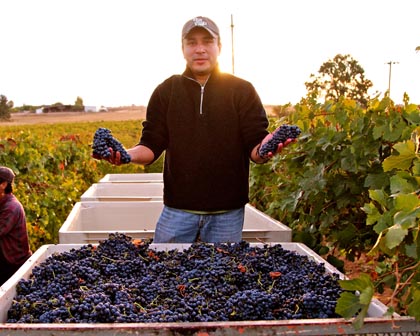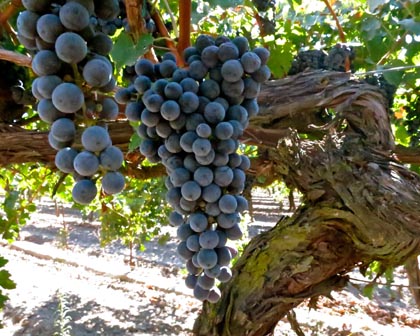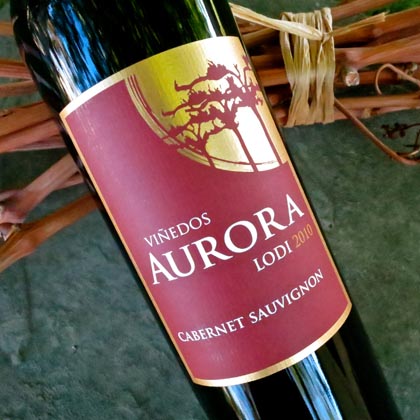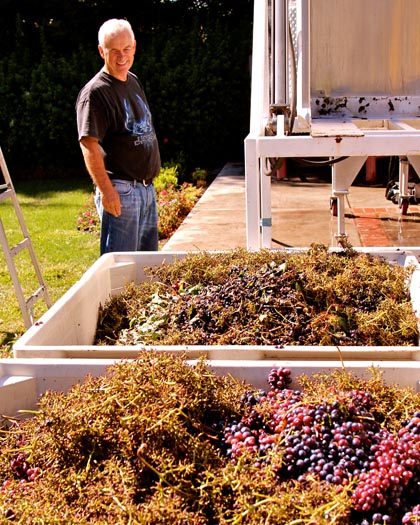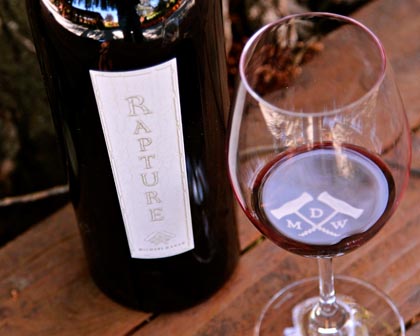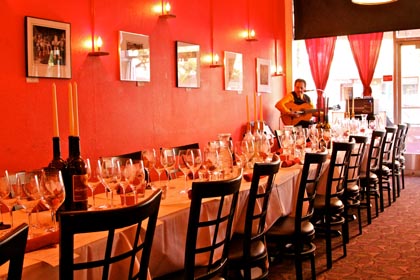Letters from Lodi
An insightful and objective look at viticulture and winemaking from the Lodi
Appellation and the growers and vintners behind these crafts. Told from the
perspective of multi-award winning wine journalist, Randy Caparoso.
Lodi’s latest Cabernet Sauvignon releases
Gerardo Espinosa of Vinedos Aurora (2013 harvest)
Zinfandel, as everyone knows, has always been Lodi's big schtick; which is why it's easy to forget that this American Viticultural Area is easily California's largest grower of grapes like Cabernet Sauvignon and Chardonnay. Lodi, in fact, crushes more Cabernet Sauvignon than Napa and Sonoma combined.
Where does all this Cabernet Sauvignon go? Most of it into the fermenting vats of big wineries, of course; and quite a bit of it blended anonymously with Cabernet Sauvignon bottlings from other regions, like Napa Valley and Paso Robles. As old-timers like to point out, this is why there's a Lodi Lane in the middle of Napa Valley – the wry old joke being, "there's a lot of Napa Valley Cabernet Sauvignon grown in Lodi."
Cabernet Sauvignon destined for Michael David’s “Rapture”
Over the past 10, 12 years, a couple of Lodi based wineries – namely the Phillips family's Michael David Winery and Mettler Family Vineyards – have also been making waves with their own own, multi-award winning Cabernet Sauvignon bottlings. Adam Mettler, who happens to be the winemaker of note behind the wines of both the Phillips and the Mettler families, has always contended that Lodi has the ability to grow Cabernet Sauvignons that can "compete with the best Cabernet Sauvignons in the world," while also reminding everyone that "this is not Napa." Says Mettler, "We have our own style of Cabernet Sauvignon," says Mettler, "one that's a little softer, and more fruit forward than what you find in Napa Valley."
Viñedos Aurora Lodi Cabernet Sauvignon
That said, there are two new Lodi grown Cabernet Sauvignons about to be released. First, an exceptionally well priced 2010 Viñedos Aurora Lodi Cabernet Sauvignon ($21) that is a 100% varietal typical of the Delta region: full bodied but not weighted down with heavy or drying tannin; but rather, is more fruit forward with sweet berry qualities laced with slightly smoky, tobacco-like, herbal-minty notes; rounded, fleshy, almost chocolaty in texture.
One of the most interesting stories in Lodi Wine Country's recent history has been the success of Viñedos Aurora: 90 acres of Clements Hills-Lodi AVA Cabernet Sauvignon and Petite Sirah being farmed by the four sons of Victor Anaya Rocha, who first began coming to San Joaquin Valley from Michoacán, Mexico to work the fields in the mid-1940s. Victor Jr., Ramon, Armando and Gerardo Anaya recently joined with the son of their sister Leticia Anaya, Gerardo Espinoso, who has demonstrated talent as a winemaker; and together the Anayas and Mr. Espinoso own and operate the Viñedos Aurora winery and estate.
Taking things to another level, Mr. Espinosa has also recently teamed up with local celebrity chef, Ruben Larrazolo of Alebrijes Mexican Bistro, to open Viñedos Aurora at Pamplona Tapas in Downtown Lodi – where you can experience all of the Viñedos Aurora wines with Spanish style tapas. In their Cabernet Sauvignon release dinner two weeks ago, Larrazolo and Espinosa introduced the wine with a mildly spiced (coriander, clove, cinnamon and peppercorns) lamb pilaf: tender morsels of lamb served with black wild rice cooked in lamb broth – a perfect way to highlight the meaty yet soft, smoky, fruit slivered style of the Viñedos Aurora Cabernet Sauvignon.
Sorelle’s Mike Scott
Another great Lodi story: Mike Scott and his family launched Sorelle Winery just four years ago with a plan to specialize in Italian wine grapes like Sangiovese, Barbera and Primitivo (the latter, a clonal selection of Zinfandel brought in from Southern Italy in the 1990s), in tribute to the Italian heritage of Mrs. Scott (Joanne, who comes from the Caporusso family).
Nevertheless, Scott has always harbored a personal preference for Cabernet Sauvignon, the black skinned grape that is native to Bordeaux, France. Says Scott, "Cabernet Sauvignon was always my first love, but we found a way to make one in an Italian way." To wit: earlier this year the Scotts released an Italian style red, the 2010 Sorelle Lodi Russo Red ($34), made from a blend of Cabernet Sauvignon (75%) and Sangiovese, and named in honor of Mrs. Scott's family.
In the Scotts' follow-up vintage, however – the upcoming 2011 Sorelle Lodi Russo Red ($34) – the blend has been changed up for aesthetic reasons: it is 75% Sangiovese, and just 25% Cabernet Sauvignon. Why? Explains Scott, "We lined up wines blended in almost every conceivable way – from more than 90% Sangiovese to more than 90% Cabernet Sauvignon – and the blend that seemed to taste the best was the 75% Sangiovese." The 2011 Russo Red, in fact, while less fleshy and round than the 2010, comes across as more fragrant with red berry and burnt leaf/walnut shell complexities, and is zestier, edgier, and more refreshing on the palate.
Because of the change in the 2011 Russo Red's blend, there was enough Cabernet Sauvignon left in barrel for the Scotts to bottle their first-ever, soon-to-be-released 100% Cabernet Sauvignon, the 2011 Sorelle Primo Amore Lodi Cabernet Sauvignon ($35) – primo amore, of course, in reference to Mr. Scott's "first love." If you love pure Cabernet Sauvignon, you'll love the Primo Amore: its pungent minty/green pepper varietal notes mixed with scents of black fruit and sweet oak; and a firm, medium-full body propped up by moderate tannins, finishing with roasting coffee-spice sensations.
Rapture
Without a doubt, the most lavish Lodi grown Cabernet Sauvignon remains that of Michael David Winery: their current release – the 2010 Michael David Lodi Rapture ($59) – is a deep, purplish red wine that literally gushes with blueberry and blackberryish fruit nuanced with black tea; tasting dense yet plush in the mouth, with layers of lingering fruit and generous oak (aged in 100% new French oak barrels) giving an ample, luxurious feel.
Typical of the house style, says Mr. Mettler, "We blend up to 8%, 9% Petite Sirah to offset the soft style of Cabernet Sauvignon we get in Lodi." Despite the fact that Michael-David buys Cabernet Sauvignon from a number of terrific growers throughout the region, the Rapture is sourced entirely from the Phillips family's own vineyards – primarily a 36-acre Cabernet Sauvignon planting located on the south side of Armstrong Rd., originally planted in 1985. The vineyard, on quadrilateral trellising, now suffers from a little bit of dead-arm (i.e. eutypa) disease, and will soon need to be pulled out and replanted. Meanwhile, says Mettler, "It still makes great wine, and shows what Lodi can do with Cabernet Sauvignon!"
Table set for Cabernet Sauvignon release at Vinedos Aurora at Pamplona Tapas
